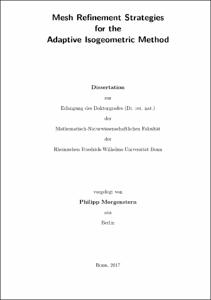Morgenstern, Philipp: Mesh Refinement Strategies for the Adaptive Isogeometric Method. - Bonn, 2017. - Dissertation, Rheinische Friedrich-Wilhelms-Universität Bonn.
Online-Ausgabe in bonndoc: https://nbn-resolving.org/urn:nbn:de:hbz:5n-48044
Online-Ausgabe in bonndoc: https://nbn-resolving.org/urn:nbn:de:hbz:5n-48044
@phdthesis{handle:20.500.11811/7237,
urn: https://nbn-resolving.org/urn:nbn:de:hbz:5n-48044,
author = {{Philipp Morgenstern}},
title = {Mesh Refinement Strategies for the Adaptive Isogeometric Method},
school = {Rheinische Friedrich-Wilhelms-Universität Bonn},
year = 2017,
month = sep,
note = {This thesis introduces four mesh refinement algorithms refine_hb, refine_thb, refine_ts2D and refine_tsnD for the Adaptive Isogeometric Method using multivariate Hierarchical B-splines, multivariate Truncated Hierarchical B-splines, bivariate T-splines, and multivariate T-splines, respectively. We address, for refine hb and refine_thb, boundedness of the overlap of basis functions, boundedness of mesh overlays and linear complexity in the sense of a uniform upper bound on the ratio of generated and marked elements. The existence of an upper bound on the overlap of basis functions implies that the system matrix of the linear equation system to solve is sparse, i.e., it has a uniformly bounded number of non-zero entries in each row and column. The upper bound on the number of elements in the coarsest common refinement (the overlay) of two meshes, as well as linear complexity are crucial ingredients for a later proof of rate-optimality of the method. For refine_ts2D and refine_tsnD, the overlap of basis functions is bounded a priori and did not need further investigation. We investigate the boundedness of mesh overlays, linear independence of the T-splines, nestedness of the T-spline spaces, and linear complexity as above. Nestedness of the spline spaces is crucial in the sense that it implies the so-called Galerkin orthogonality, which characterizes the approximate solution as a best-approximation of the exact solution with respect to a norm that depends on the problem. Altogether, this work paves the way for a proof of rate-optimality for the Adaptive Isogeometric Method with HB-splines, THB-splines, or T-splines in any space dimension. In order to justify the proposed methods and theoretical results in this thesis, numerical experiments underline their practical relevance, showing that they are not outperformed by currently prevalent refinement strategies. As an outlook to future work, we outline an approach for the handling of zero knot intervals and multiple lines in the interior of the domain, which are used in CAD applications for controlling the continuity of the spline functions, and we also sketch basic ideas for the local refinement of two-dimensional meshes that do not have tensor-product structure.},
url = {https://hdl.handle.net/20.500.11811/7237}
}
urn: https://nbn-resolving.org/urn:nbn:de:hbz:5n-48044,
author = {{Philipp Morgenstern}},
title = {Mesh Refinement Strategies for the Adaptive Isogeometric Method},
school = {Rheinische Friedrich-Wilhelms-Universität Bonn},
year = 2017,
month = sep,
note = {This thesis introduces four mesh refinement algorithms refine_hb, refine_thb, refine_ts2D and refine_tsnD for the Adaptive Isogeometric Method using multivariate Hierarchical B-splines, multivariate Truncated Hierarchical B-splines, bivariate T-splines, and multivariate T-splines, respectively. We address, for refine hb and refine_thb, boundedness of the overlap of basis functions, boundedness of mesh overlays and linear complexity in the sense of a uniform upper bound on the ratio of generated and marked elements. The existence of an upper bound on the overlap of basis functions implies that the system matrix of the linear equation system to solve is sparse, i.e., it has a uniformly bounded number of non-zero entries in each row and column. The upper bound on the number of elements in the coarsest common refinement (the overlay) of two meshes, as well as linear complexity are crucial ingredients for a later proof of rate-optimality of the method. For refine_ts2D and refine_tsnD, the overlap of basis functions is bounded a priori and did not need further investigation. We investigate the boundedness of mesh overlays, linear independence of the T-splines, nestedness of the T-spline spaces, and linear complexity as above. Nestedness of the spline spaces is crucial in the sense that it implies the so-called Galerkin orthogonality, which characterizes the approximate solution as a best-approximation of the exact solution with respect to a norm that depends on the problem. Altogether, this work paves the way for a proof of rate-optimality for the Adaptive Isogeometric Method with HB-splines, THB-splines, or T-splines in any space dimension. In order to justify the proposed methods and theoretical results in this thesis, numerical experiments underline their practical relevance, showing that they are not outperformed by currently prevalent refinement strategies. As an outlook to future work, we outline an approach for the handling of zero knot intervals and multiple lines in the interior of the domain, which are used in CAD applications for controlling the continuity of the spline functions, and we also sketch basic ideas for the local refinement of two-dimensional meshes that do not have tensor-product structure.},
url = {https://hdl.handle.net/20.500.11811/7237}
}






